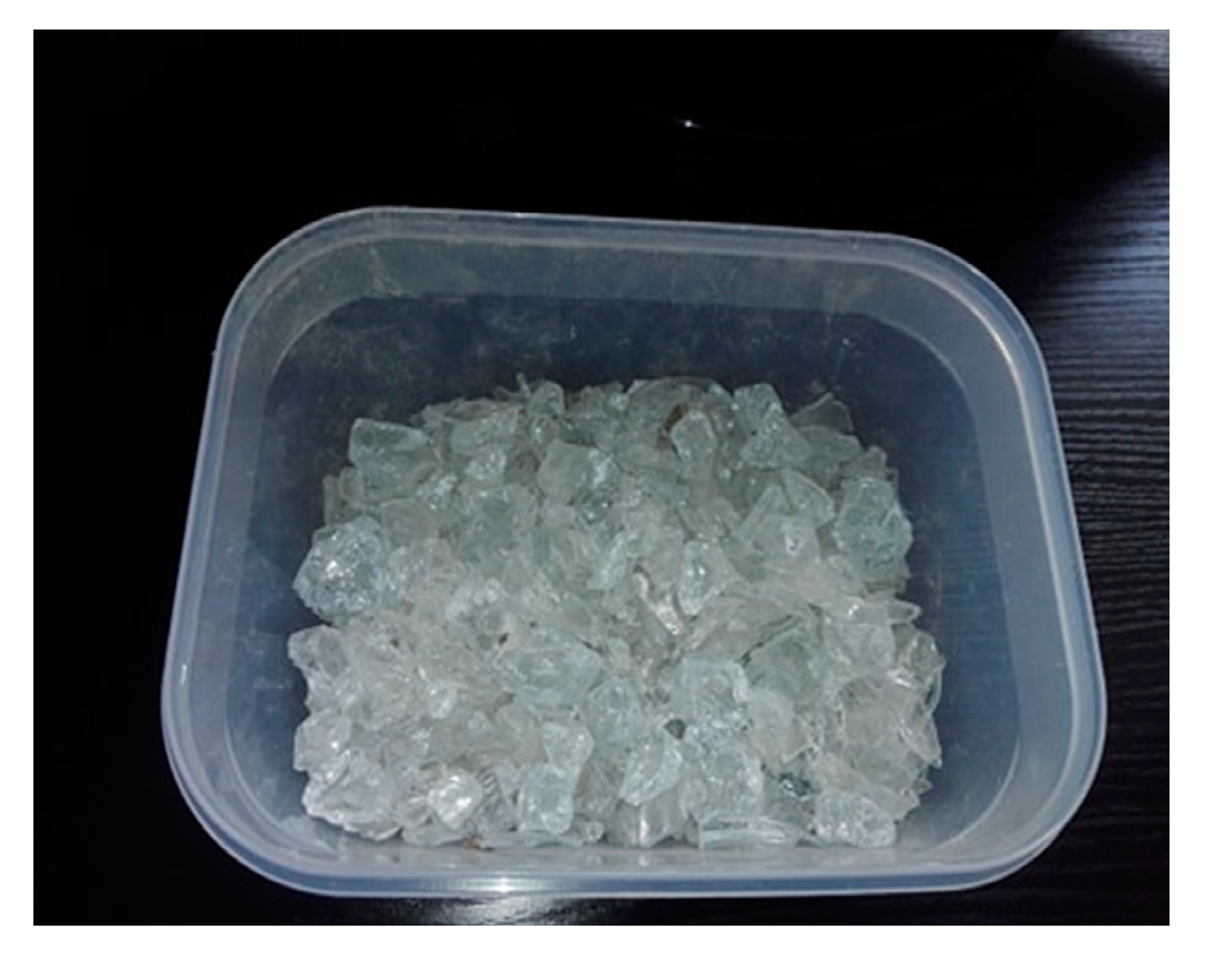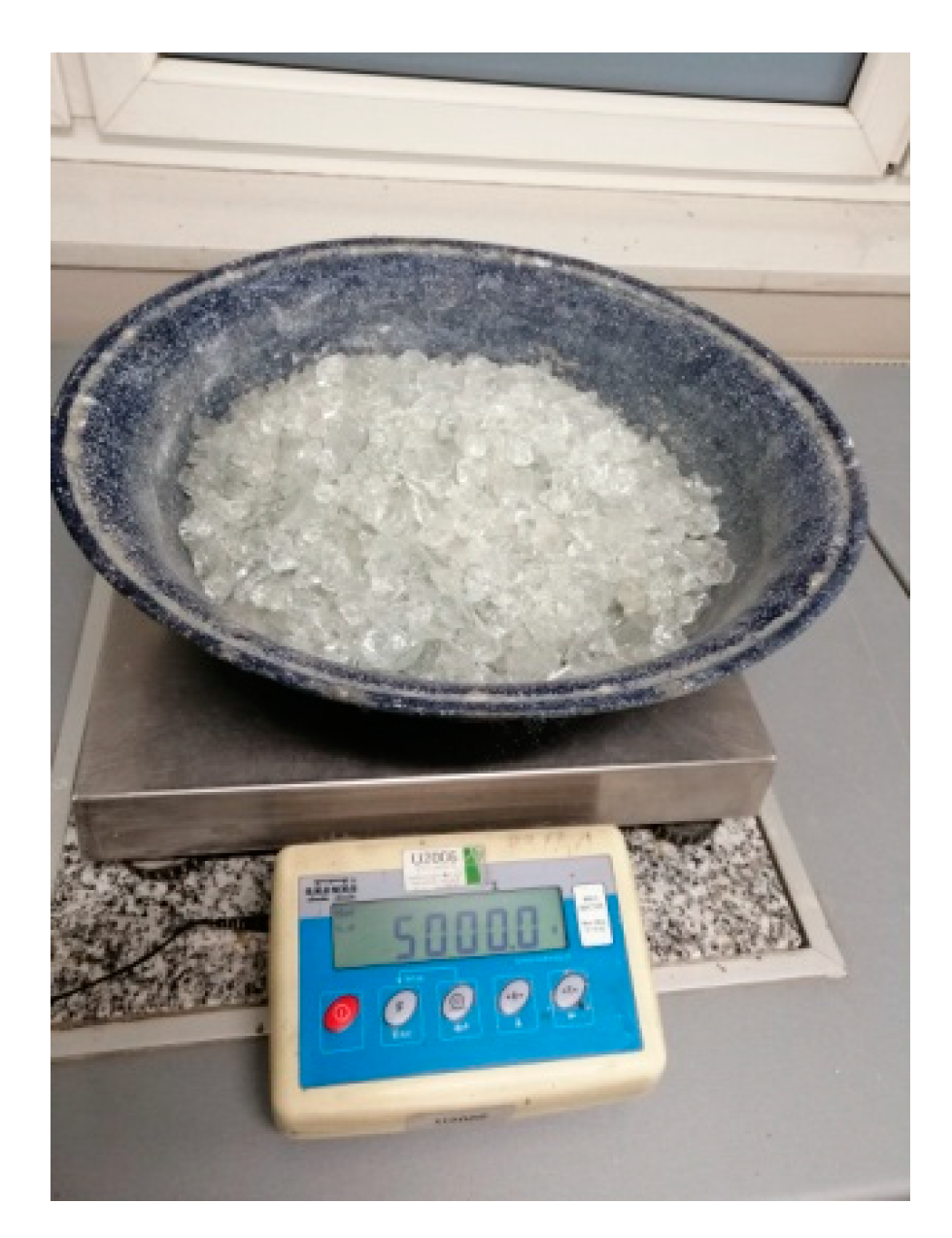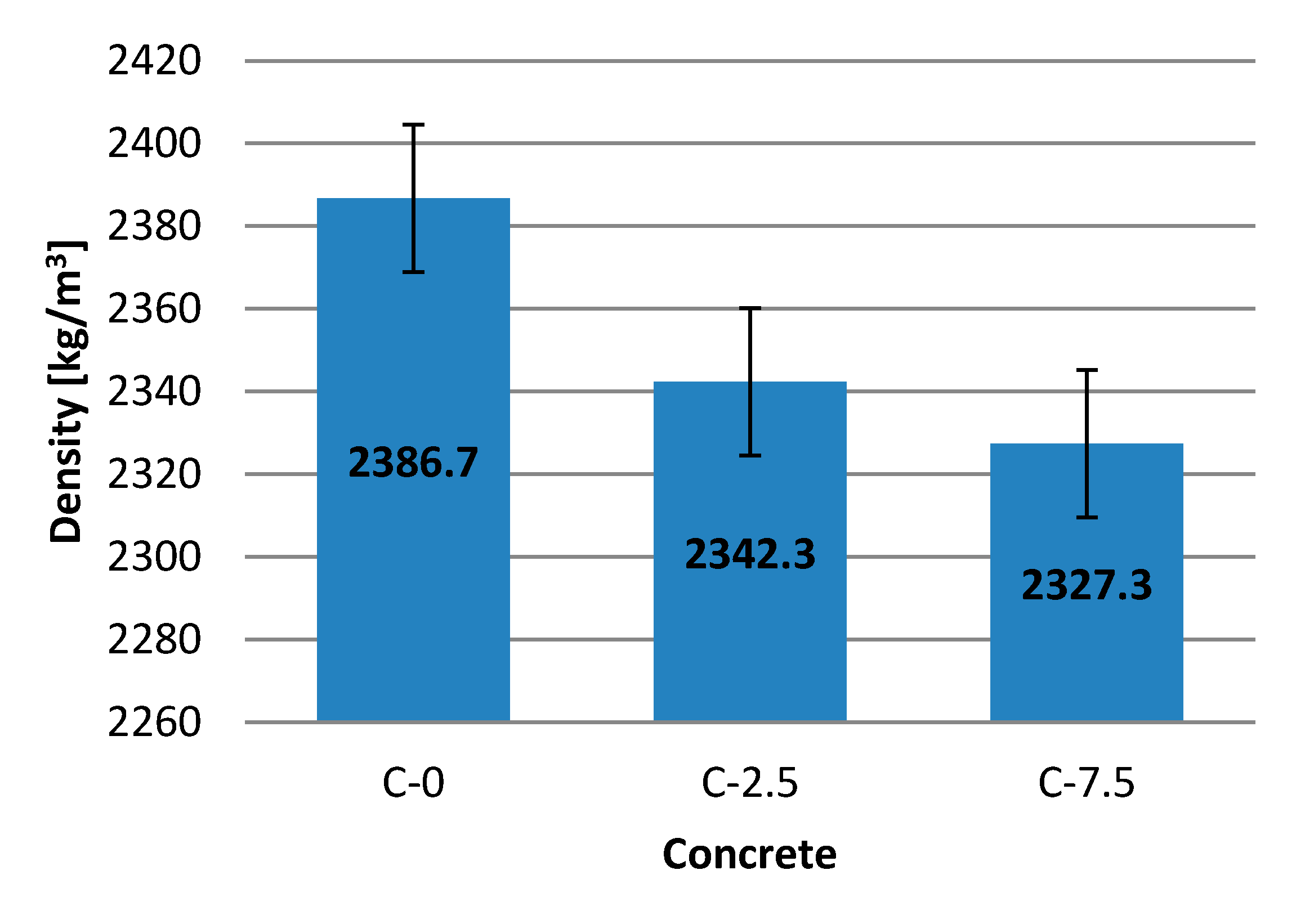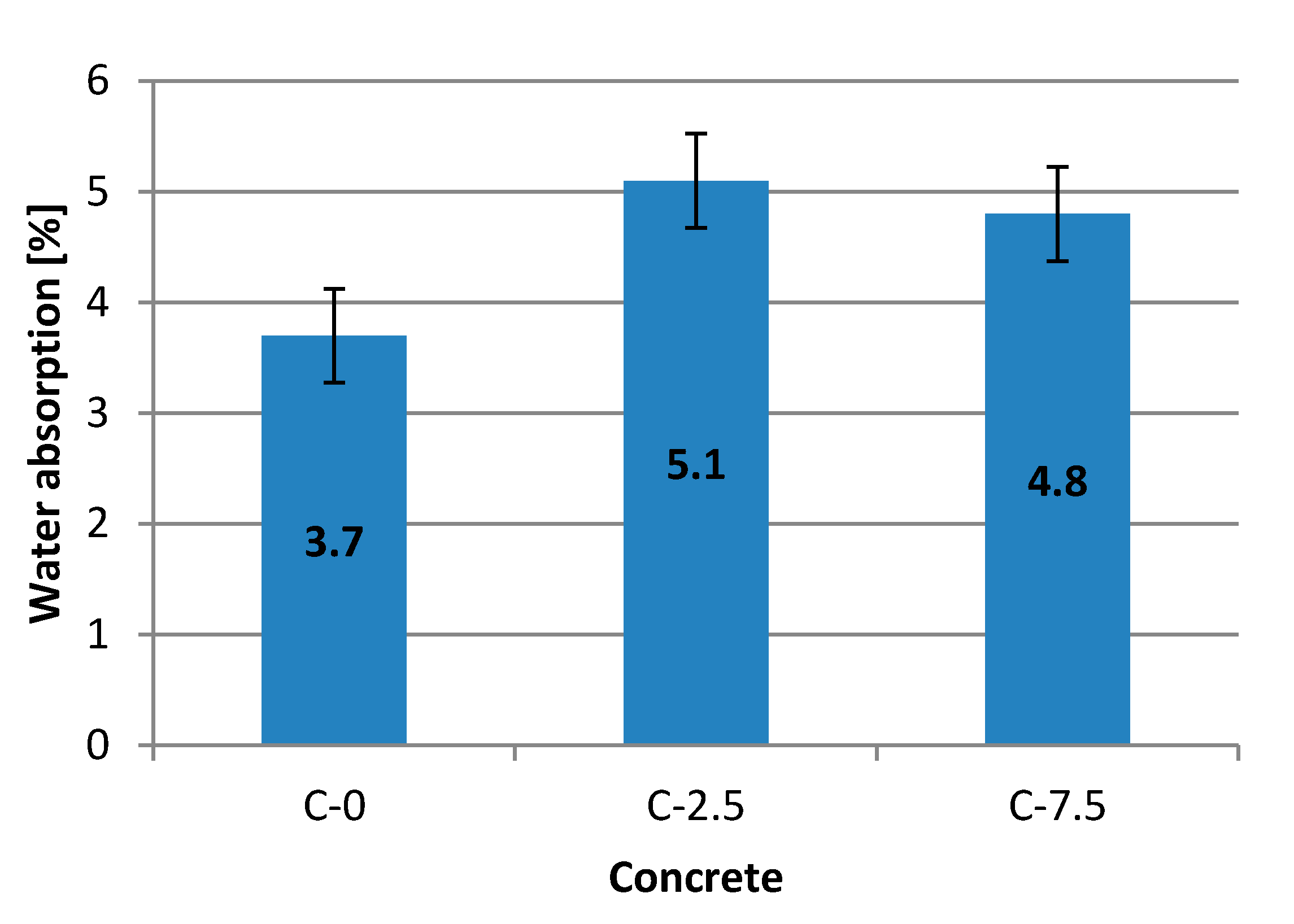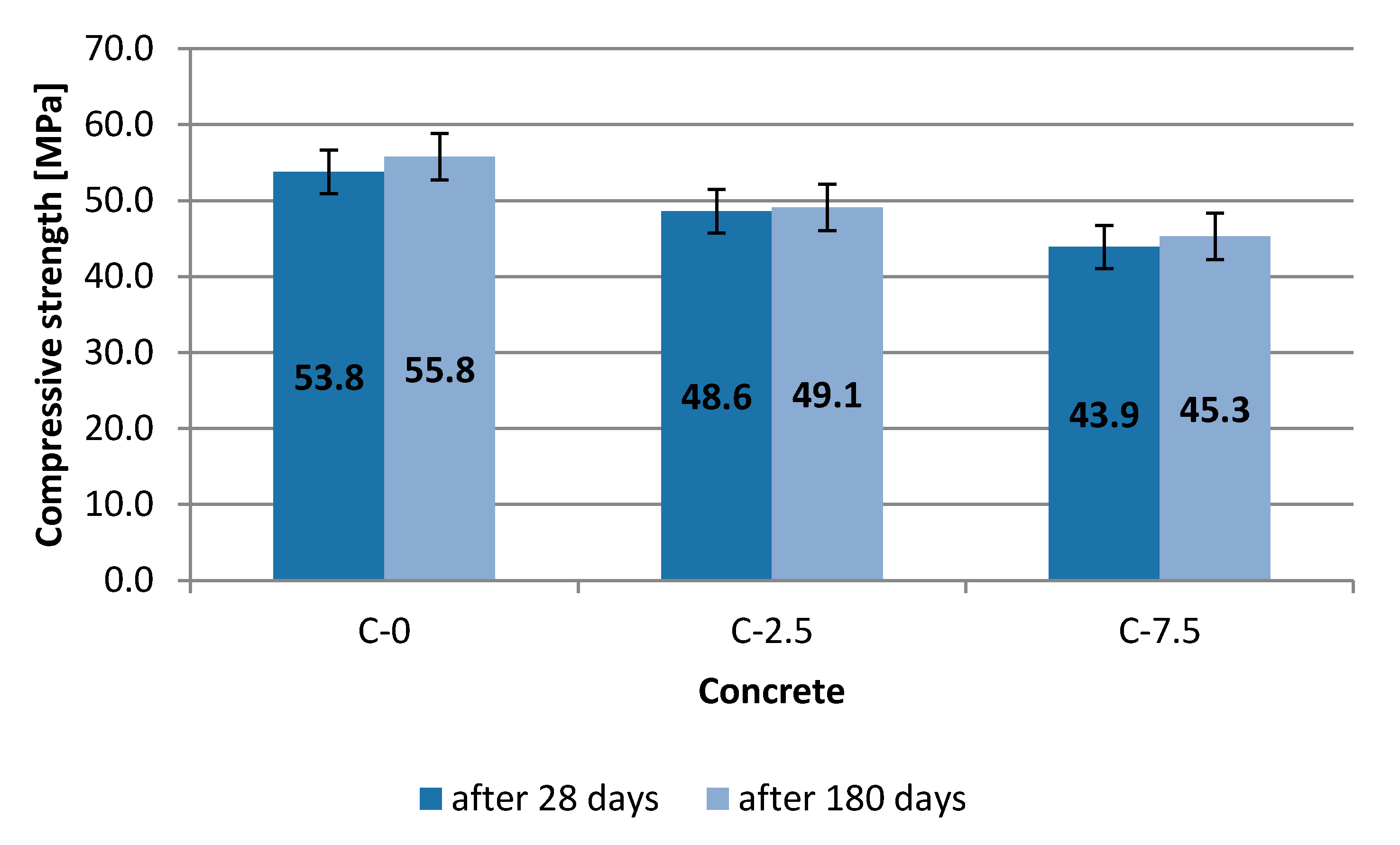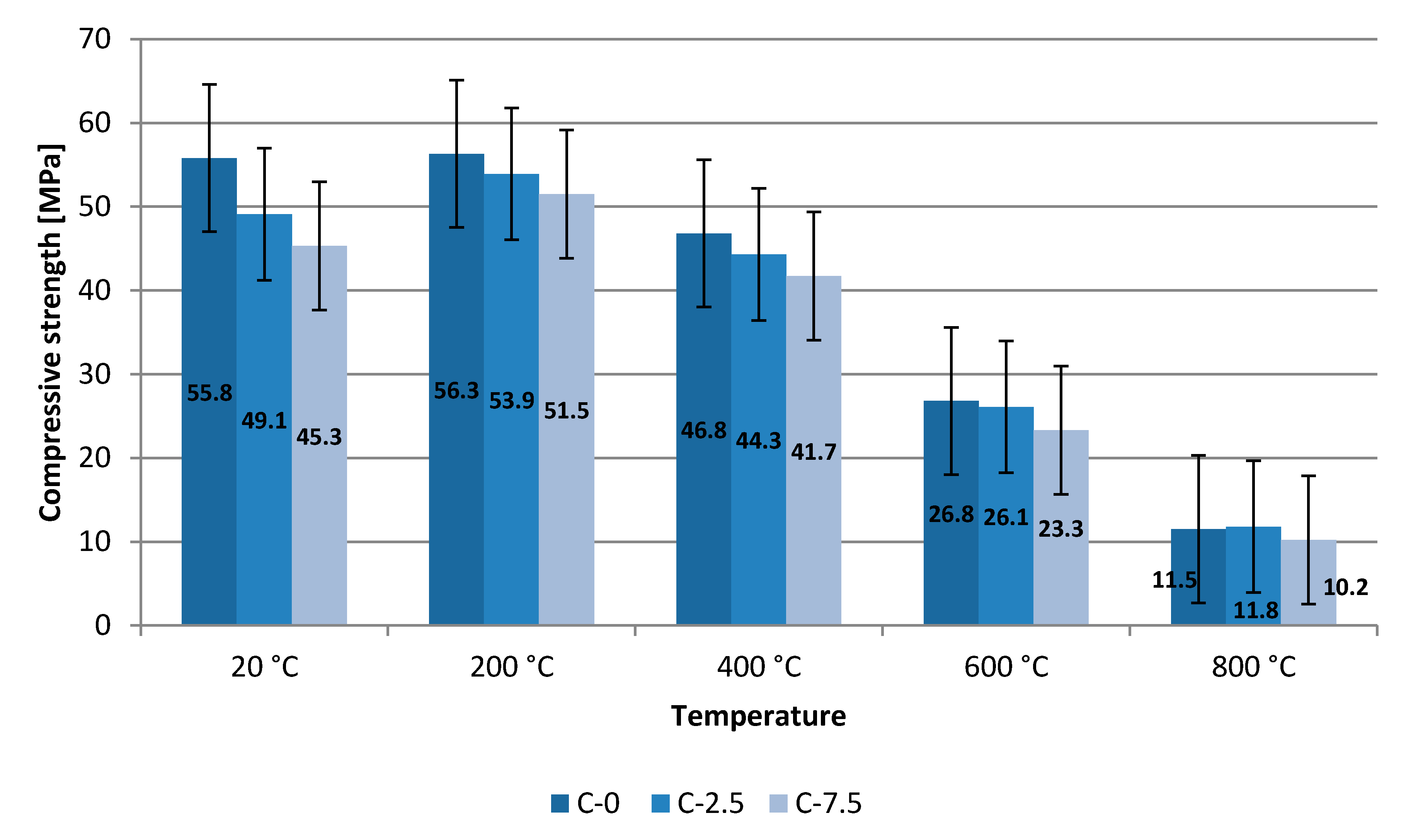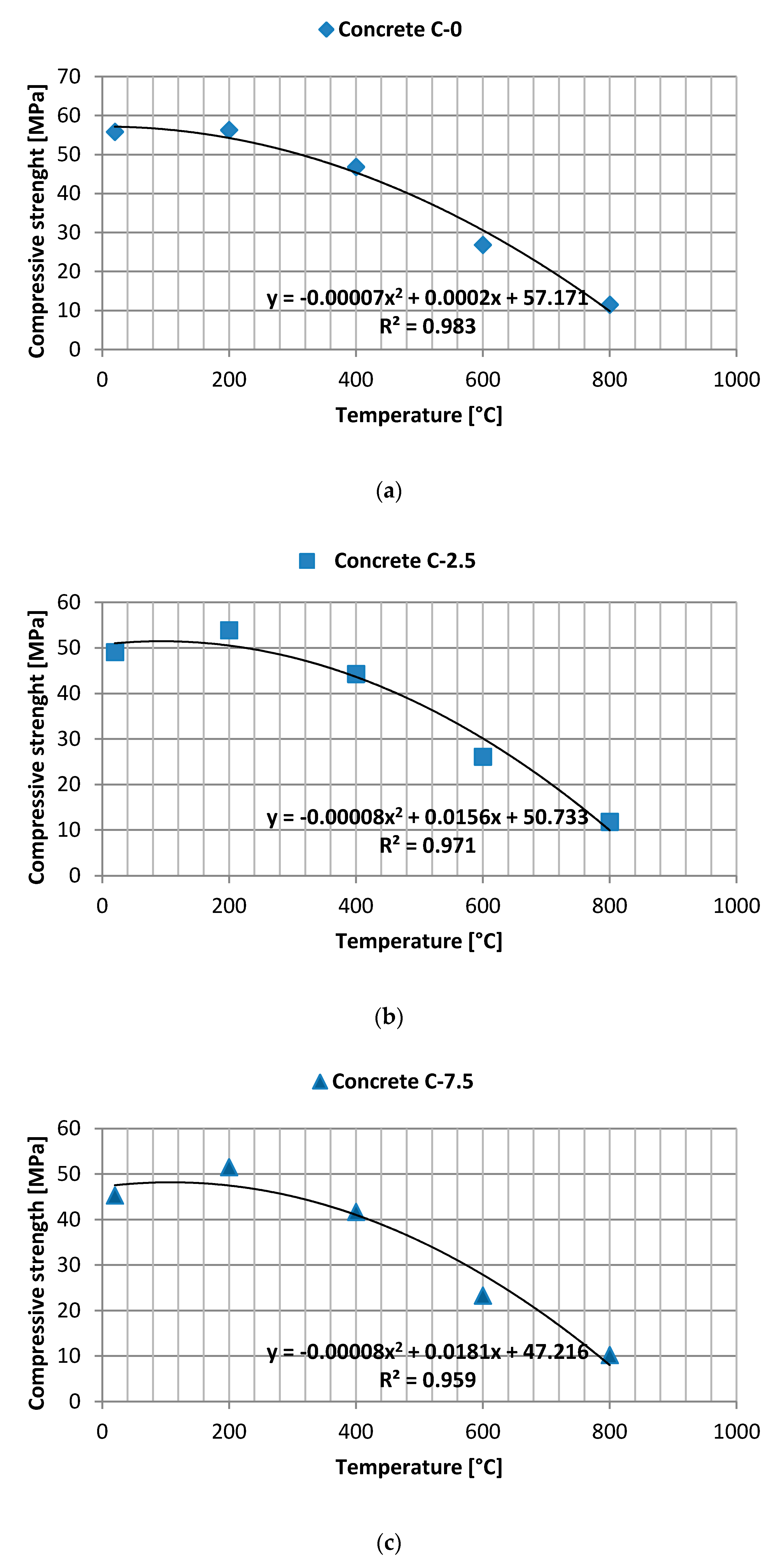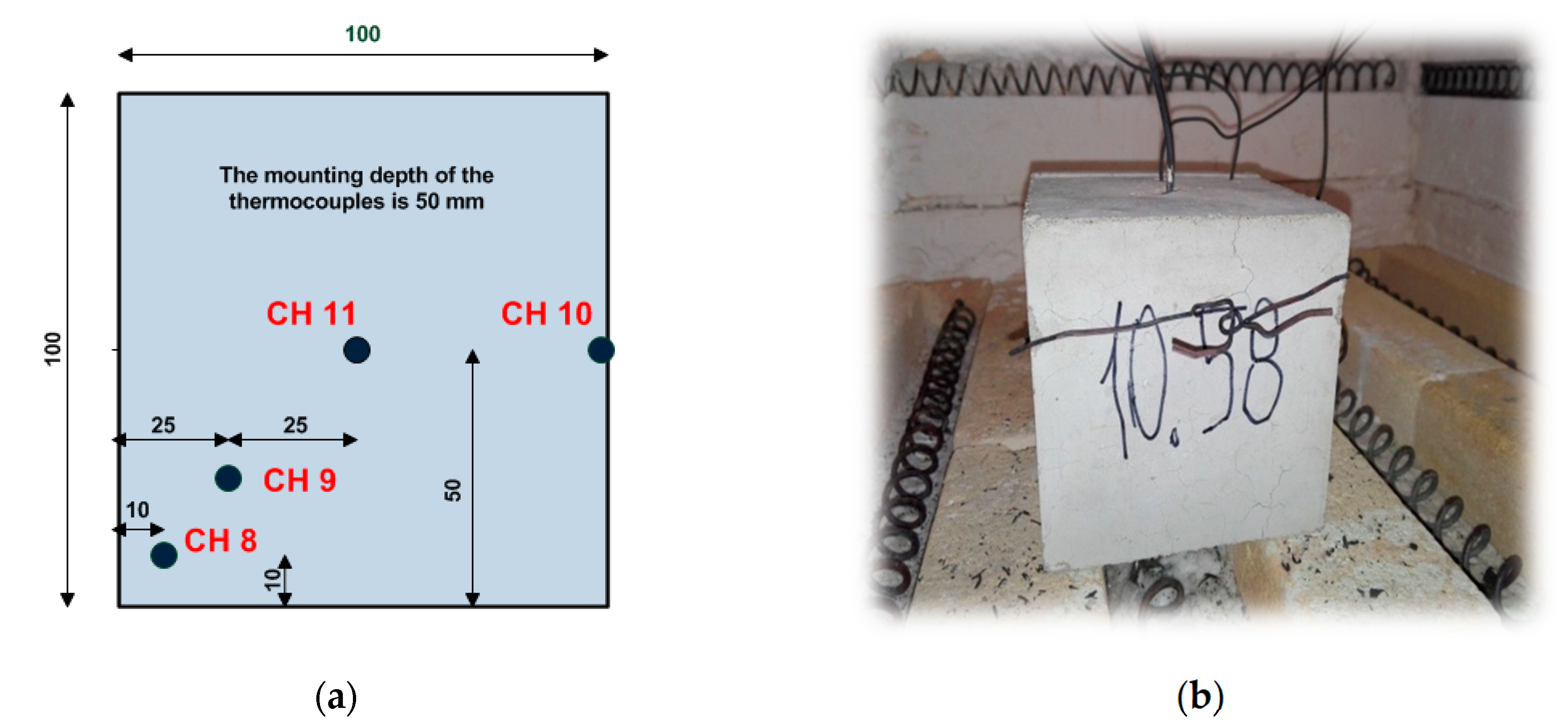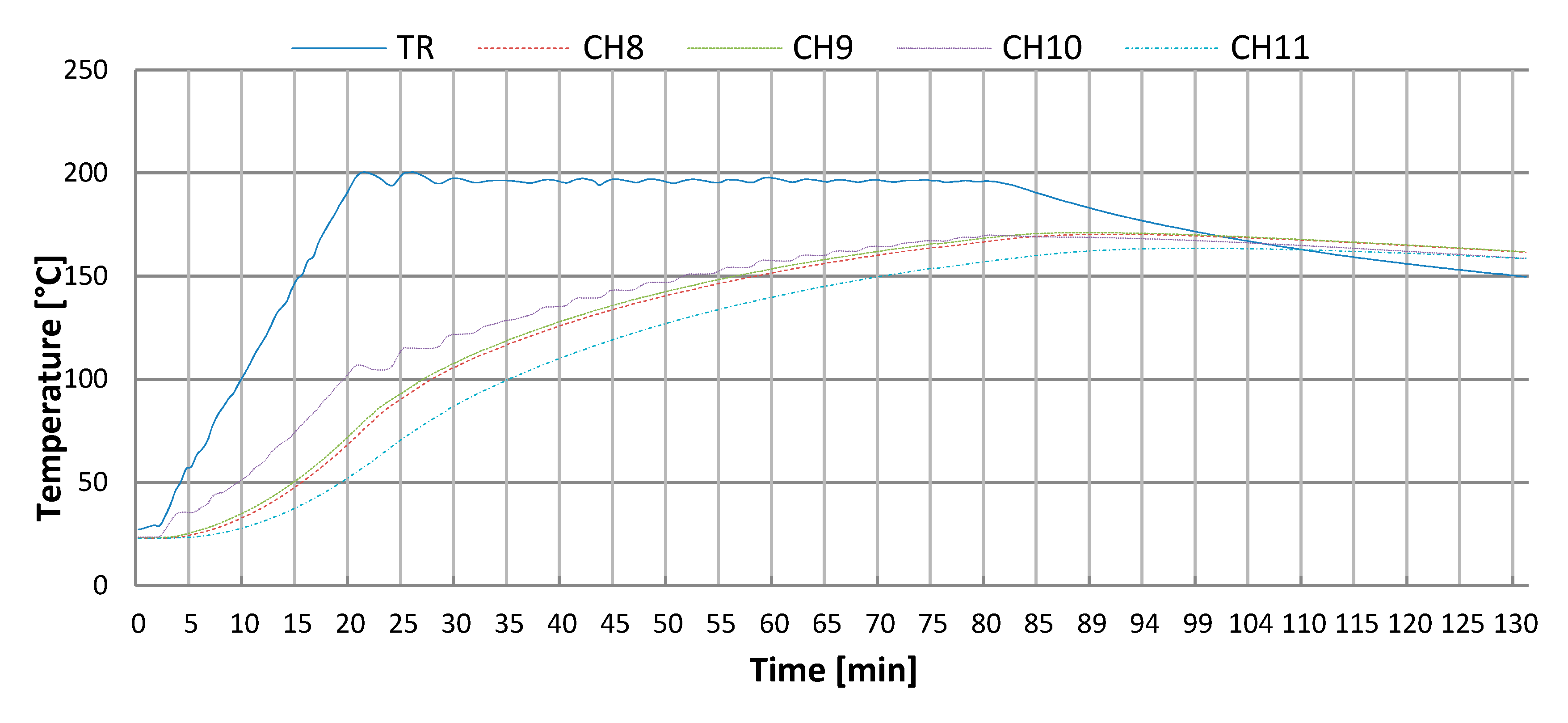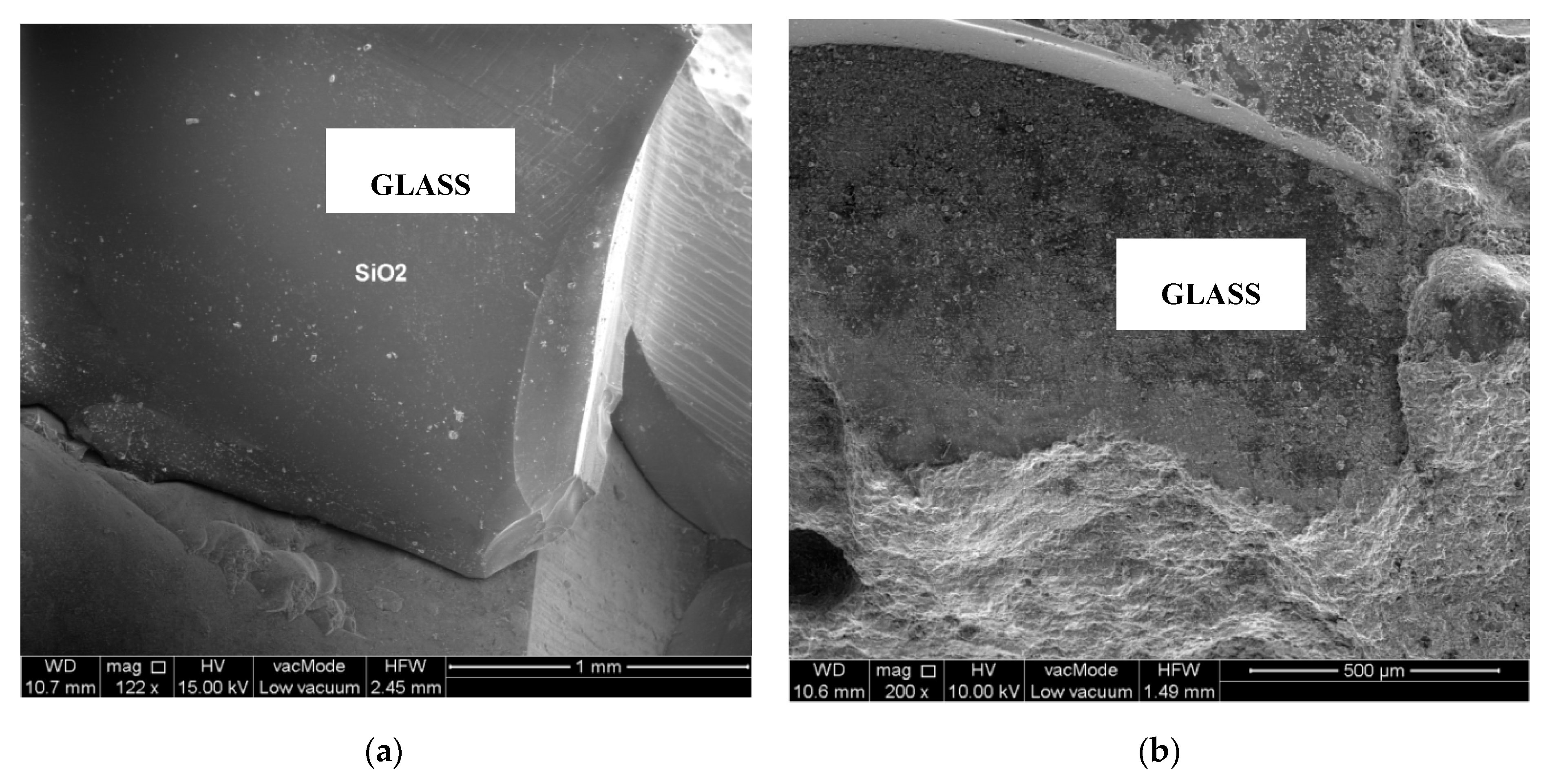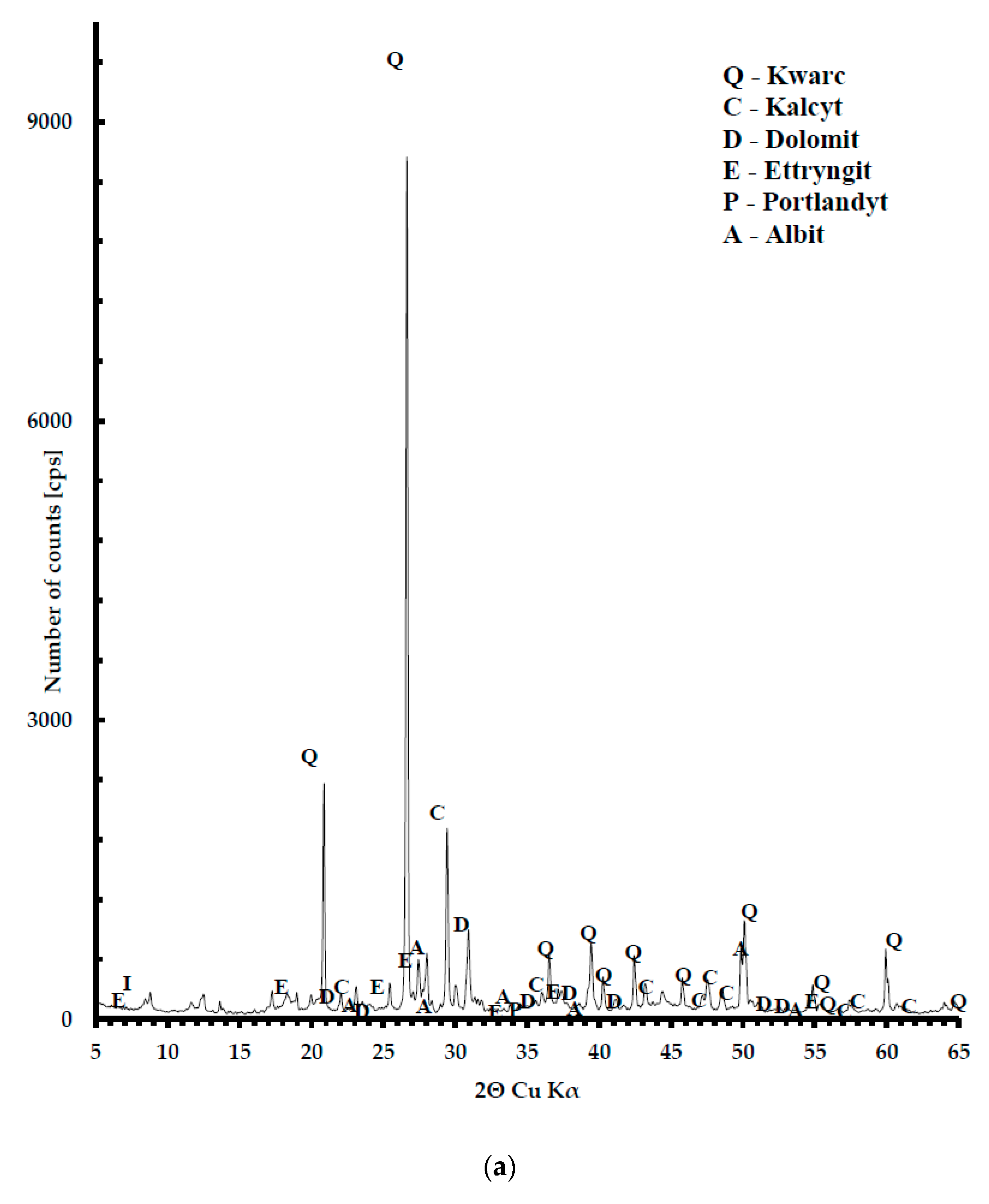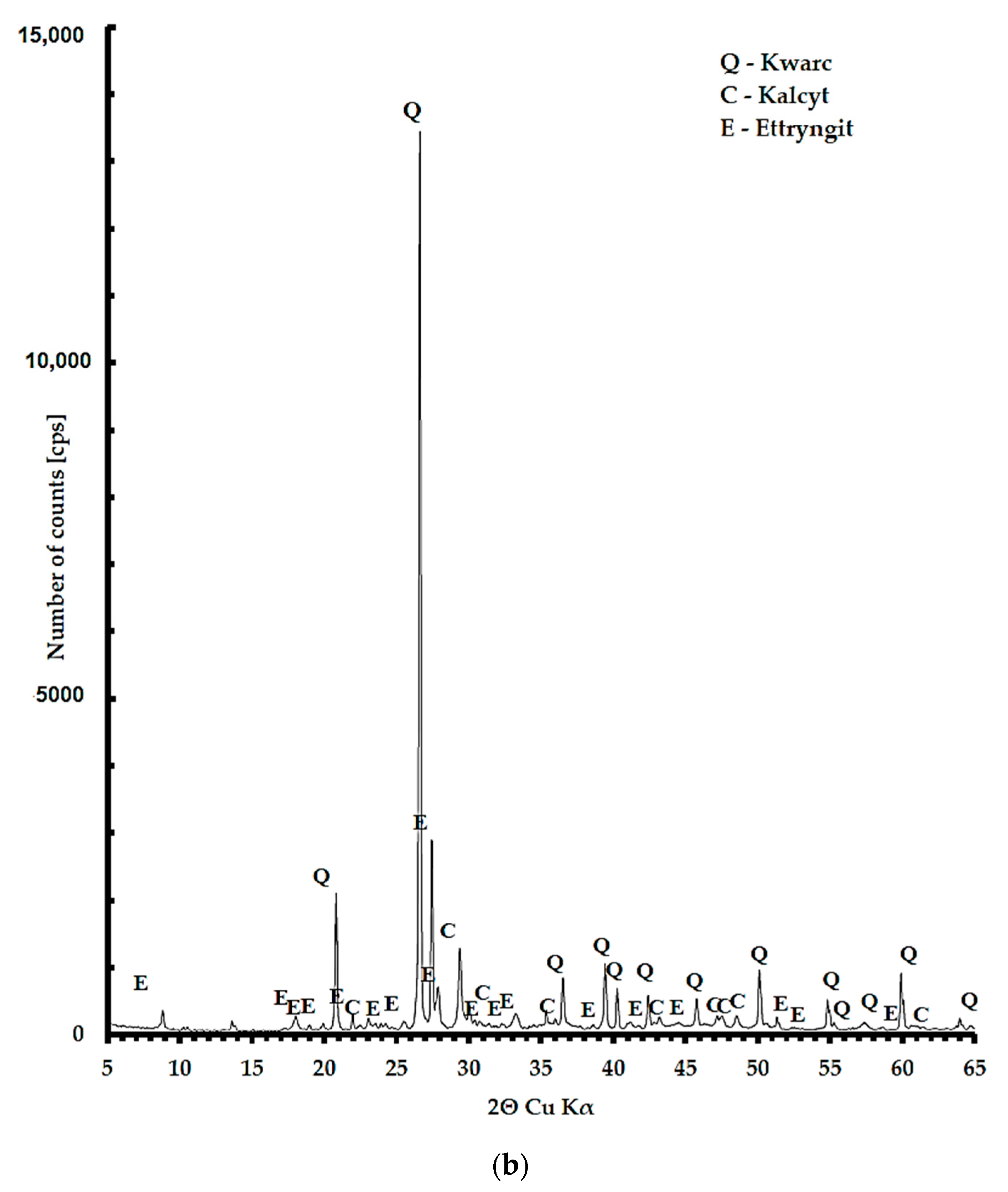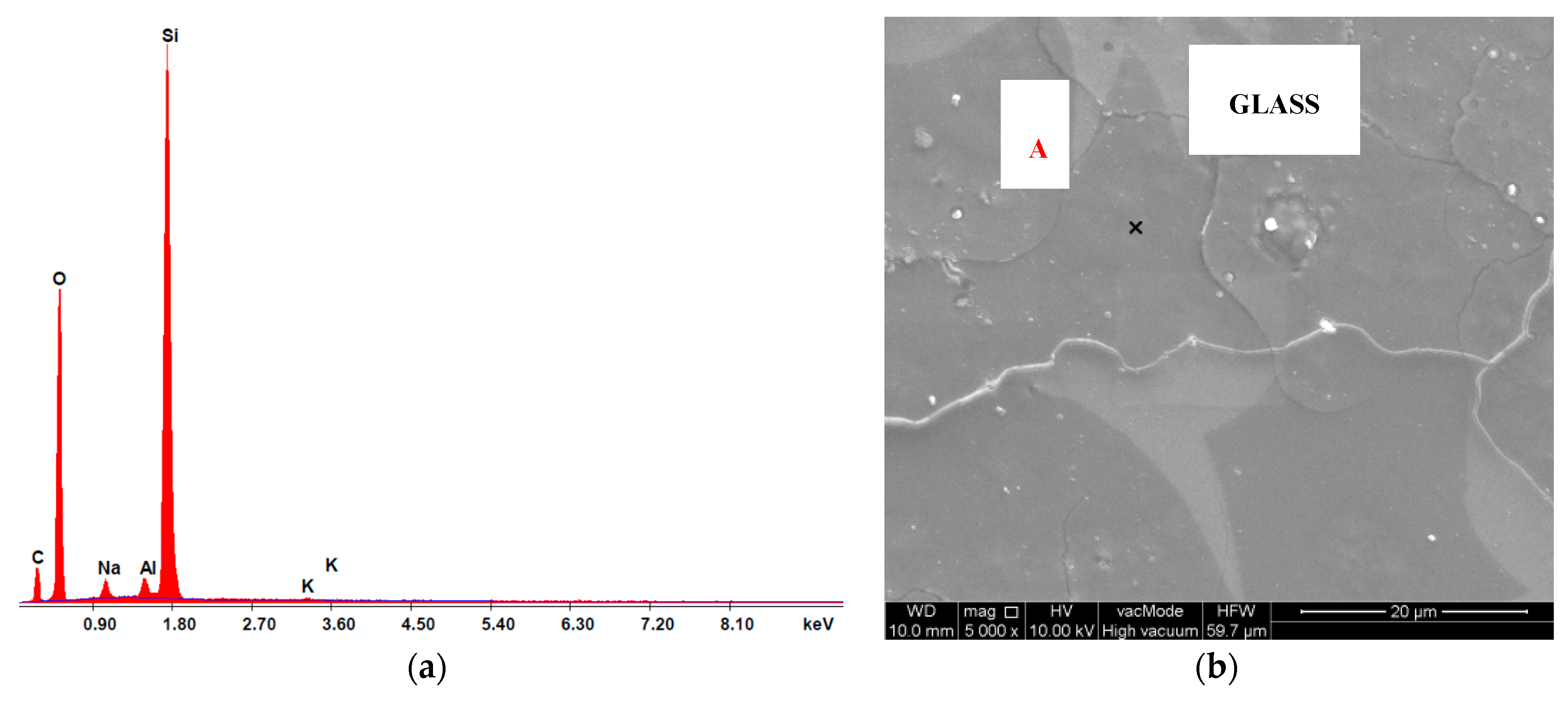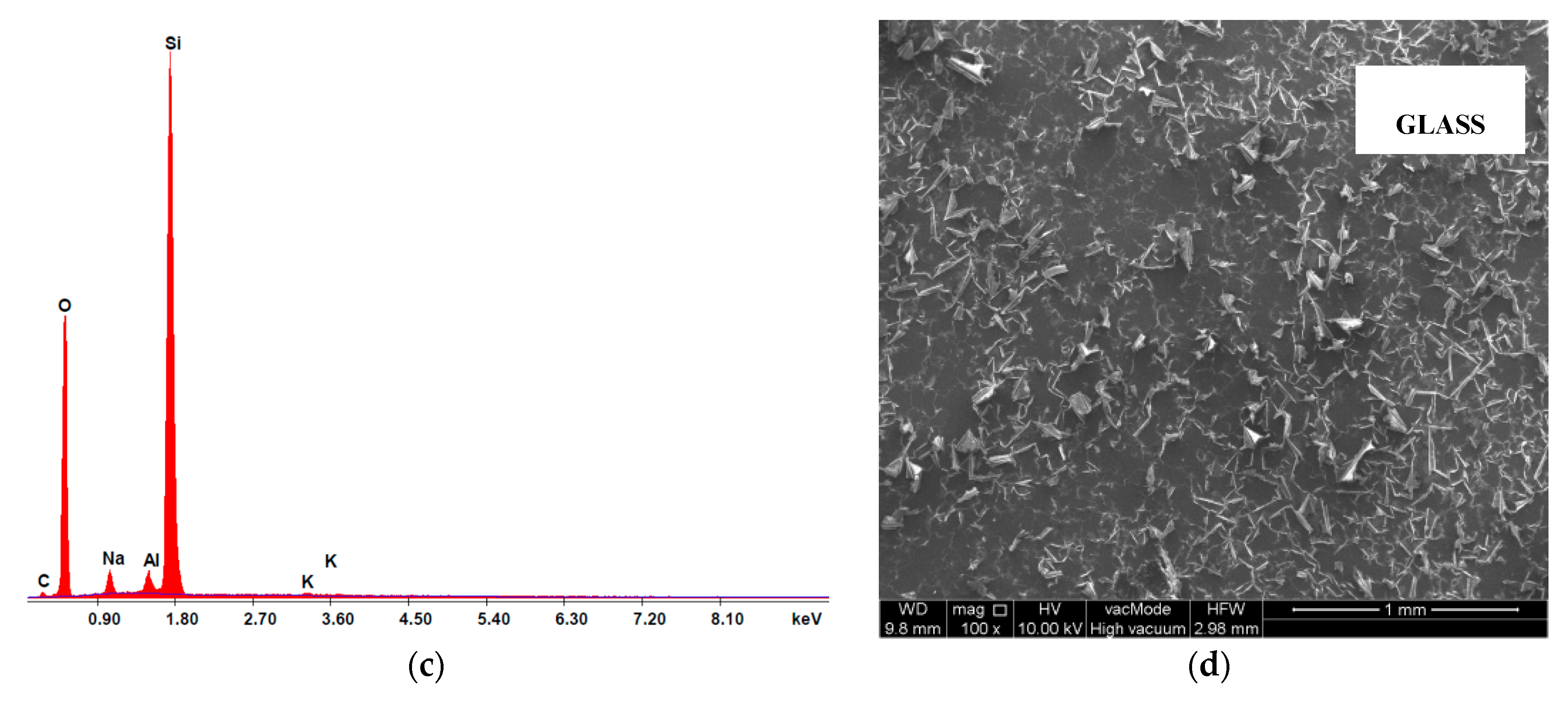1. Introduction
Glass is commonly used in the construction industry and in various industries branches. It is an inspiration in the search for new applications that require an interdisciplinary approach to the design and implementation processes [
1].
Glass is distinguished by its transparency and is also a relatively hard material. Depending on its brand, it occupies the fifth or sixth position in the 10-level Mosh hardness scale. Its main weakness is its fragility. It is made of glass sand (source of silica SiO
2), borax (source of glass forming component B
2O
3), sodium–potassium feldspar (source of Al
2O
3), sodium carbonate, limestone and others. Components of glass brands used in the construction sector comprise circa 70–72% SiO
2, circa 15% Na
2O, circa 10% CaO, as well as MgO, Al
2O
3 and other ingredients adopted to improve the properties of glass or to streamline the production process [
2]. Glass is a fragile material, which means that once it reaches its maximum strength, it cracks and becomes crushed. Compared to steel or concrete, glass is characterised by high compressive strength equalling to 0.8–1 GPa. The tensile and flexural strength of glass is much lower and equals 30–90 MPa. In addition, glass has a high Young’s modulus equalling to circa 70 GPa. This value is comparable to the Young’s modulus of aluminium [
1]. Apart from traditional functions, glass is meant among others to insulate and to protect from burglary or from a fire. The resistance of ordinary glass to high temperatures, such as those that occur during a fire, is very low. After a few minutes it becomes completely destroyed. Construction glass (single-layer silica glazing) cracks and falls out of the frame after being heated to 200 °C. Much better properties are offered by reinforced silicate glass, which may crack, yet it does not fall out from the frame that holds it. Borosilicate glass is characterised by a high chemical resistance, withstands high temperatures for a longer time, maintains tightness, but concurrently also permits passage of thermal radiation to the protected zone. It is also characterised by “flexibility” at fire temperature that prevents its cracking [
3].
Studies carried out to date indicate that glass waste constitutes 7–10% of all waste deposited on landfills. Recycling of cullet limits the usage of sand, limestone, soda, etc., as well as even water, by 50% with concurrent reduction of energy by circa 30%. This allows lowering the emission of contamination to the atmosphere. Approximately 30% of glass packaging items are processed to cullet. Each obtained tonne of glass cullet allows a saving 800 kg of sand, 250 kg of soda and 180 kg of limestone powder. This shows that the usage of glass from recycling contributes to a reduction in the volume of landfills and widely promotes the circular economy [
4,
5].
In response to social needs, the necessity of maintaining the market competitiveness and a user friendly natural environment, research implemented to date with respect to elementary features of composites using concrete and ceramic recyclates and cullet go along with the concept of sustainable construction engineering. Recycling of waste glass seems to be an advantageous solution in production of raw materials and manufacturing of secondary products, for example in the sector of civil engineering (recycling of construction aggregate) [
6,
7,
8,
9,
10].
Glass used for the production of concrete needs to undergo a special processing procedure [
5,
11]. The whole material may be recycled. It should be borne in mind that glass from broken mirrors, window and car glazing, glasses, wine glasses, heat resistant dishes, light bulbs, ceramic products, porcelain and earthenware articles, bowls, plates, grave candles, medication glass packaging, etc. may not be processed in furnaces designated for cullet obtained from packaging elements [
12]. Before it may be added to the concrete mixture, recyclate needs to be tested, because it changes properties of the mixture and hardened cement composite; among other effects it delays hydration and prolongs the initial and final setting time.
Numerous researchers are looking for innovative solutions that would meet performance requirements and determine the inventive nature of the use of waste cullet. Recently conducted studies [
13,
14,
15,
16,
17,
18,
19,
20,
21,
22,
23,
24] enable the determination of the suitability of using waste materials for the production of ceramics, binders, mortar, concrete, plaster, bituminous materials etc. For testing requirements, use is made of various types of cullet, from car glazing [
25], soda-lime glass from containers [
26,
27,
28], glass from technological lines of the pharmaceutical industry [
29,
30,
31], cathode ray tubes for TV sets and computer screens [
32,
33], float glass from window glazing [
5], glass from fluorescent lamps [
13], glass from heat resistant dishes [
34] and mirrors, safety glass, crystal glass, and colourless, green and brown packaging glass [
34,
35,
36,
37,
38,
39] among others.
Cullet is used as a substitute for cement, sand and coarse aggregate in concrete, and in addition may be used for stabilisation of natural soils or for the construction of roads and subgrades [
5,
40]. The powder fraction of ground glass may also be used in concrete as a pozzolanic material [
41].
When designing a cement composite, cullet may be introduced into concrete in the form of fibres, dust or grains. The addition of glass consisting of fibres [
42,
43,
44,
45,
46,
47,
48,
49,
50] has an advantageous impact on parameters of concrete. Concrete gains a better strength and is resistant to such environmental factors as humidity, solar radiation, thawing and freezing.
Replacing cement in the concrete mixture with crushed glass powder [
37,
38,
39] allows the attainment of a composite characterised by better workability and improvement of compressive and flexural strength after a prolonged curing time. Recyclate is characterised by pozzolanic reactivity, which is correlated with average compressive strength [
10,
51].
When using glass cullet as a substitute for sand [
34,
35,
36,
37,
52], the type of applied glass needs to be taken into consideration. The application of a 10–30% addition of cullet causes a 10–25% drop compressive strength in resistance compared to the control sample [
53].
Studies performed until now have proven that it is possible to adopt a solution based on replacement of coarse natural aggregate by waste aggregate. Studies took into consideration glass [
54,
55,
56,
57] and ceramic waste [
58,
59]. From the ecological and economic viewpoint this solution appears to be advantageous, proecological and safe for the environment. It does not require a large amount of work as, for example, in the case of fibres or crushing to a powdered form.
A review of published research [
5,
11] has shown that no analyses have been implemented yet with respect to recycling of used up heat resistant dishes for the production of concrete. While conducting the research, the authors took into account the feasibility of using glass recyclate as an optional supplementing aggregate for the production of cement composites exposed to thermal loads. Analysis was carried out of selected physical, mechanical and structural properties of the composite.
3. Research Methods
The technical properties of concrete are a set of all the physical, mechanical, rheological properties and their resistance to the impact of the environment. The article presents a few selected properties of the composite: absorbability, apparent density, compressive strength, deformability under the impact of temperature change (rheological properties), resistance to high temperature and microscopic structure testing.
3.1. Granulometric Distribution
Optimum grading is found in the aggregate with the smallest number of cavities between grains, with containing possibly the coarsest aggregate grains. To determine the grading of glass cullet a sieve analysis was carried out. The recyclate was sifted through a set of sieves on a shaker, and then fractions remaining on the sieves and on the bottom were weighed. The test was performed pursuant to standard EN 933-1:2012 [
61].
3.2. Resistance to Grinding Recyclate
The resistance to grinding was determined by measuring the fragmentation of the aggregate as a result of rolling together the aggregate with steel balls in a rotating drum. The Los Angeles (LA) factor corresponds to the mass of the analytical sample in fragmentation, expressed in %, which has passed through a 1.6 mm sieve after a complete drum rotation cycle. The test was carried out in accordance with the standard PN-EN 1097-2.
3.3. Properties of Fresh Concrete
Tests were conducted of the consistence of concrete mixtures according to the standard EN 12350-2:2009 [
63]. The mixture was found to have good workability. The achieved consistence class was S2/S3/S4 according to fall of the Abrams cone; the difference in height of the form and receded mixture was in the range of 75–170 mm. The concrete mixture density was tested according to the standard EN 12350-6:2009 [
64].
Before the commencement of proper tests, all the samples were weighed and dried to constant mass in the thermal chamber KC-100/200 (Zalmed, Warszawa, Poland), which was repeated until two consequent measurements were found not to differ one from the other by more than 0.1%, at the temperature of 105 °C ± 5 °C. All measurements of the mass were implemented to within an accuracy of 0.001 g.
3.4. Properties of Hardened Concrete
Test trials were conducted with a view to the determination of physical and mechanical properties. An absorbability test was implemented pursuant to the standard EN 206:2013 [
65]. Construction standards define the admissible absorbability of concrete up to 4%. Cement grout coats the grains and hinders the permeation of water, while voids are filled with water and serve as “buffers”.
Mechanical tests were carried out in laboratory conditions at room temperature with the use of a hydraulic press. The production and curing of concrete samples designated for compressive strength tests were performed according to the standard PN-EN 12390-2 [
66]. The samples were cubic formed, with dimensions of 10 cm × 10 cm × 10 cm, and were placed in a climatic chamber. The elements were unmoulded after 24 h, and marked in a durable and legible way by a symbol defining the type of mixture and number of sample. Immediately after the removal of the elements from the moulds, all of them were once again placed on the grates over the water surface in a climatic chamber to mature for 28 days.
The measurement unit was a Controls Advantest 9 press (Controls, Cernusco sul Naviglio, Italy) including specialist software (Version 2.16-02/2010). Compressive strength is strictly correlated with the microstructure of hardened cement grout and the strength of aggregate and the aggregate–grout contact zone. Compressive strength (f
c) was determined according to the standard PN-EN 12390-3 [
62]. On the basis of obtained average strength values, the result was converted onto cubic samples with side length of 15 cm (according to formula 1) and classes of concrete were defined.
where:
fc,cub150 and
fc,cub100—compressive strength ascertained on cubic samples with edge lengths of 15 and 10 cm, respectively.
3.5. Tests of Concrete at Elevated Temperature
The samples were heated at the temperature of 200 °C, 400 °C, 600 °C and 800 °C in a special furnace PK 1100/5 (Termolab S.C., Warszawa, Poland) furnished with powered heating compartments. The stand has a dedicated programme ThermoPro that allows the programming of the thermal process. The temperature distribution in the analysed element was monitored using NiCr-Ni thermocouples that meet criteria defined by the standard [
67].
3.6. Scanning Electron Microscopy with Energy Dispersion Microscopy (SEM/EDS)
In order to identify phases based on a qualitative chemical analysis and crystalline structure, to obtain high resolution images of the forms of very small items and to obtain spatial differences in the chemical composition, scanning electron microscopy (SEM) was used. The observations were implemented using the FEG Quanta 250 microscope (FEI, Hilsboro, OR, USA) equipped with an EDS system (EDAX, Mahwah, NJ, USA), based on energy dispersion microscopy used to conduct analyses of the chemical composition with the aim of obtaining maps of the distribution of elements and spot chemical analyses of the material. This enabled the determination of semi-quantitative chemical composition of the observed phases. The EDS detector analyses X-ray radiation that indicates the elemental composition of the tested sample.
Using the X-ray diffractometer (PANalytical, Almelo, The Netherlands), analyses were performed of the topography and phase composition of the designed composite. Materials needed for testing were obtained from fragments of crushed samples remaining from the strength testing.
Samples for SEM testing were coated with powder and fixed to the grip with the use of a carbon adhesive. Next the samples were given a circa 50 nm carbon coating as a result of cathode spraying to assure conductivity on the sample surface.
4. Results and Discussion
The objective of the test was to find how waste cullet affects the properties of cement composite. The research population comprised three modified composites (C-0, C-2.5, C-7.5) containing various amounts of recycled aggregate (0%, 2.5%, 7.5%). From each population 15 samples were collected. The experiment includes observations and assessment of selected properties of the sample (statistical features).
A granulometric analysis was carried out for glass cullet. Tests comprised assessment of the density, absorbability (humidity), compressive strength, resistance to elevated temperature, composite structure, and topography of the tested material. Chemical elements contained in the composites were identified.
4.1. Granulometric Analysis of Waste Cullet using the Sieve Method
Granulometric determination was done on a glass sample obtained from recycling, and then a calculation was made of the degree of uniformity. Results of the sieve analysis were applied onto a semi-logarithmic grid and in such a way that a continuous grading curve was obtained (
Figure 2) for recycled aggregate.
The glass aggregate curve is not contained within the area of the limiting sifting curves (upper and lower ones). The sand content of recyclate equals 1.27%. The recyclate fails to meet standard requirements of particularly good grading. The recyclate curve is below the lower limiting curve, yet that does not discriminate recyclate as an additive to concrete. The glass mixture comprises aggregate with a fraction of 0/16 mm.
4.2. Aggregate Resistance to Grinding—Los Angeles Method
Steel spheres and a 5000 g analytical sample were placed in the Los Angeles drum (
Figure 3). 500 rotations of the drum were performed, with a constant speed of 31−33 rpm. After 16 rotation cycles, the sample was wet sieved on a 1.6 mm sieve, according to PN-EN 933–1. The residue on a 1.6 mm sieve was dried at a temperature of 110 ± 5 °C to a constant weight—3134 g. The test result is a Los Angeles (LA) coefficient of 37.32 so the LA fragmentation category is
. On this basis, the strength class of the cement composite (C16/20 to C30/37) was determined for which the glass cullet can be used.
4.3. Physical Properties of Hardened Concrete
Bulk density (apparent density) was tested on cubic samples (100 × 100 × 100) mm. For the testing three samples of each concrete were used. Results of the test are shown in
Table 8 and
Figure 4.
Bulk density decreases with the increase in the amount of recyclate in the sample, and differs for all types of concrete. Cement composite C-7.5 with the addition of glass recyclate obtained a density of 2327.3 kg/m
3. The reduced density could have been caused by building up of the contact zone between the binder and aggregate. The porosity of the composite is also affected by reaction of the used aggregate and the binder. Changes in the zone of adhesive-aggregate were also observed in studies [
5,
68]. However, in publication [
13] certain differences have been observed in density, caused by the growing contents of air in the mixture.
The subsequent test comprised the determination of total absorbability (humidity) of the material by the weight method. Tests comprised 15 samples of each type of concrete. Next the samples were dried to constant mass. Constant mass is achieved when sample masses does not differ one from another by 0.1%. After saturation with water the samples were heated up to a temperature of 105 ± 5 °C for 72 h, and then they were taken out and weighed. Reinserted for 24 h. After that time, the samples were taken out and measured. A total of seven cycles of this type were carried out.
The saturation time of samples and their drying are determined by standard EN 13369:2018 [
69] concerning concrete precast elements. The minimum time amounts to 3 days at change of mass below 0.1%. The authors observed similar drying times of concrete cubes (10 cm) as observed in the studies of [
70]. The drying time of samples to constant mass was 6 to 8 days.
Figure 5 presents results and an image of changes to absolute humidity of concrete during the process of moisture removal. The elementary descriptive statistics are provided in
Table 9.
Water absorption varied, and for mixtures C-0, C-2.5 and C-7.5 amounted to 3.7%, 5.1% and 4.8%, respectively. The difference in results of absorbability was 1.1–1.4%. This proved that, as the amount of glass aggregate grows, the absorption of concrete also grew, most likely also leading to the formation of air voids in the concrete volume. While analysing the results of their own studies, the authors of [
5] also drew attention to the increase in the variability index with contents of glass waste. This is further proof that as the amount of waste grows, the samples become less homogeneous.
The figure also shows error bars with standard error that equals 0.05% for concrete C-0 and 0.07% for C-2.5 and 0.06% for C-7.5. The water absorption obtained during testing is lower than 6%. According to standards pertaining to precast concrete and sidewalk elements (pavement, concrete kerbs), they should be considered as satisfactory for any class.
4.4. Compressive Strength
The compressive strength test was performed after 28 and 180 curing days of the cement composite. Samples were tested at the laboratory temperature of 20 °C. Three samples were used to determine average strength. The obtained results are presented in the bar chart (
Figure 6).
Destructive testing was carried out on samples that had not been subjected to heating. Lower values for concrete C-2.5 and C-7.5 were observed compared to reference concrete C-0 after 28 days of curing. The differences in values vary and appear to have a downtrend. Compressive strength falls with the amount of waste glass in the sample. It has been found that strength after 180 days for C-7.5 was by 3.8 MPa higher than in sample C-2.5 and concurrently lower by 10.5 MPa than for reference concrete C-0. The target strength on control samples amounted to 55.8 MPa. The conducted testing allows the presumption that a higher strength of the composite was obtained by substituting 2.5% of gravel with recyclate. Results obtained from all the tested composites may be considered to be satisfactory. The concrete was classified as C30/37, i.e., lower by one class (C35/45) or two classes (C40/50) obtained after 28 and 180 days by reference concrete C-0.
Table 10 specifies selected statistical parameters for analysed results of compressive strength. Those parameters characterise the homogenous nature of concrete.
The next destructive testing was performed on heated cubes after 180 days of curing. Heating was performed for three cubes each for temperatures of 200 °C, 400 °C, 600 °C and 800 °C. The heating process progressed in line with the standard temperature-time curve according to EN 1991-1-2. Temperature in the furnace was kept up for a further 60 min until the heating process was completed. Testing of average compressive strength took place at room temperature after total cooling down.
Figure 7 shows the results of average strength of concrete samples and presents error bars with the standard error.
An increase was observed in average compressive strength after heating the up of the samples to a temperature of 200 °C. The strength of C-2.5 concrete grew by 4.8 MPa, and for the C-7.5 concrete by 6.2 MPa in relation to the strength determined at room temperature. On the other hand, it may be considered surprising that the strength of composite C-0 increased slightly. The cement composite did not lose its properties thanks to the low coefficient of thermal expansion and the good ability of borosilicate glass to work at temperatures up to 300 °C. The impact of fire temperatures exceeding 400 °C causes a fall in strength by circa 16% (C-0), 10% (C-2.5), 8% (C-7.5). At a temperature of 600 °C the concretes were found to have a reduction of as much as by 50% compared to samples made of reference concrete.
Using smaller contents of recyclate in the concrete has a positive effect on the strength of samples subjected to a fire.
A curve of multiple regression has been plotted for temperatures and for average strength (
Figure 8) including a calculation of the correlation equation and application of the growth trend on the dispersion diagram. Once a suitable predictive equation has been obtained in the form of a function of the second degree polynomial, the following questions may be posed: How effective is the prediction for the dependent variable? In addition, what is the accuracy of an assessment of such effectiveness?
Table 11 presents relations between two variables, i.e., the r Pearson correlation coefficient (describing direction and force), coefficient of determination R
2 and the significance level for the given coefficient.
The obtained diagrams present a negative correlation, with a visible dependence ascertained between values, for which a decrease (increase) in strength is accompanied by an increase (decrease) in temperature. The coefficient of determination is significant at the level of 0.001 for C-0, 0.002 for C-2.5 and 0.004 for C-7.5.
4.5. Concrete Testing in the Event of a Fire
Before commencing the heating process, all samples were dried to constant mass. The testing was conducted according to the standard temperature-time curve according to EN 1991-1-2:2005 [
71]. The samples were heated up in a special furnace at temperatures of 200 °C, 400 °C, 600 °C and 800 °C. The heating time depended on the value of the programmed temperature. The temperature distribution in the pilot sample was recorded with the use of a computer equipped with dedicated software. The temperature distribution was monitored by four thermocouples (
Figure 9). Openings for heating thermoelements were made in the central part of the sample (CH 11), 25 mm from the edge of the base (CH 9), 10 mm from the edge of the base (CH 8). The thermocouple (CH 10) was fixed to the lateral surface of the sample. The regulating thermoelement (RT) is introduced through the posterior wall and is close to the top part of the furnace. The depth of the drilling was 50 mm.
An increase in temperature weakens the structure of the material. Cracking is visible on the sample surface. The actual distribution of temperatures shown in
Figure 10 enables observations of the behaviour of concrete in the event of a fire.
Thermocouples distributed in the pilot sample enabled modelling the progress of standardised fire. The thermal process was programmed by specifying the time of heating, temperature, as well as the number of process sections that should be implemented.
The point at which the temperatures become balanced proves that the sample had been heated evenly throughout its entire volume. In the process of cooling down a visible increase occurs in the temperature of the internal layers [
5].
4.6. Scanning Electron Microscopy (SEM) with Energy Dispersive X-ray Spectroscopy (EDS) and X-ray Diffraction Analysis (XRD)
The paper presents a continuation of deliberations commenced in article [
5], which are related by a common study subject pertaining to the impact of waste heat resistant glass cullet on the nature of phase transformations that take place in the heating phase. The studies comprised verification of microstructural properties and identification of phase composition. Tests were conducted on fracture surfaces of samples sustained in the destructive tests. Morphology of the glass obtained in the scanning microscope images are shown in
Figure 11.
Structural testing of the composition of heat-resistant glass (unheated at 20 °C and heated up to 800 °C) did not detect any significant changes. Glass is characterised by low resistance to the impact of alkali and significant resistance to water and strong acids. Silica glass SiO2 is characterised by a relatively low thermal expansion coefficient equalling circa . Consequently, it is resistant to thermal shock and the occurring differences in temperature.
The chemical composition in the micro-area of cement composite samples was analysed using the EDS attachment. The testing also comprised analysis of the risk of dehydration of samples described in the literature [
5,
72]. The oxide composition of glass cullet is presented in
Table 12 and
Table 13, and selected spectra of the chemical composition are shown in
Figure 12,
Figure 13 and
Figure 14. The chemical bonding of glass has a limited degree of modularity. As a non-crystalline (amorphous) structure, glass is characterised by transition to a liquid state during heating and a high degree of short-range modularity. The X-ray spectrum analysis defines the percentage content of particular oxides. The oxide composition of C-7.5 composite heated at 800 °C, determined from point A, is characterised by high contents of calcium oxide CaO (52.03%), silicon oxide (IV) SiO
2 (22.32%), alumina Al
2O
3 (14.35%), sodium oxide Na
2O (0.98%) (
Table 12).
The phase composition of concrete was determined using X-ray diffraction analysis (
Figure 13). It is dominated by quartz recognized by the interplanar distances d = 3.34, 4.25 Å, calcite d = 3.03, 2.85, 2.09 Å and dolomite 2.87, 2.19, 1.78 Å. The sub-components are feldspars in the form of albite d = 3.26, 3.22 and portlandite d = 2.63, 4.90 Å and ettryngit d = 9.76, 3.87 Å. The process of heating to a temperature of 800 °C caused the entire decomposition of dolomite and portlandite, which initiated the process of carbonation of the cement binder.
The glass composition analysis was conducted after glass was subjected to the impact of temperatures of 20 °C and 800 °C, with the determination made from point A and the area of the collected sample. The results are specified in
Table 13. An analysis of the chemical composition of recyclate showed slight differences in the content of the main chemical components. The content of silicon oxide increases, at the expense of which the proportion of alkali oxides (Na
2O and K
2O) slightly decreases. The content of Al
2O
3 ranges from 3.68 to 4.69% which allows the statement that the tested concrete is thermally resistant.
The spectra of the chemical composition (
Figure 14a,c and
Figure 15a,c) confirm the presence of elements contained by glass cullet that originate from quartz (SiO
2) and oxides K
2O, Na
2O among others. In addition, peaks coming from alumina AL
2O
3, which enhanced mechanical, chemical and thermal properties of silicate glass were ascertained.
Based on the conducted structural testing and data obtained from published studies pertaining to analyses of absorption spectra in infrared of Raman spectra, a presumption may be made that cement composite containing an additive of heat-resistant glass is less susceptible to strains resulting from thermal expansion [
72,
73,
74]. The material is less susceptible to cracking after thermal shock.
